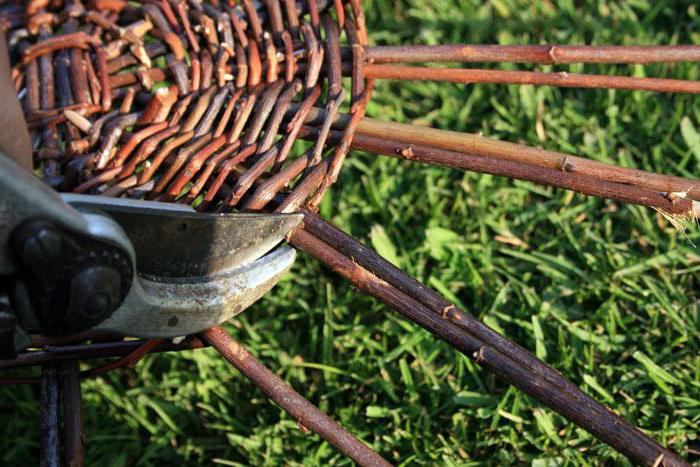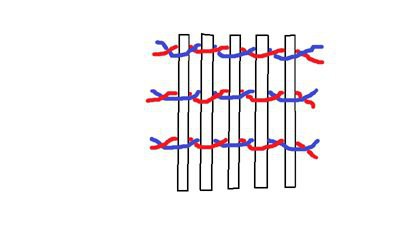One of the most popular types of needlework is weaving from vines and willow twigs. The information provided will be especially interesting for beginners who want to master this type of art.
Article Summary
The following questions will be considered in the article:
- Collection of willow rod and its preparation for further work.
- Important aspects that must be mastered for productive work.
- Tools and devices that facilitate the weaving of willow baskets.
- The simplest and most popular weaving technique.
Having mastered weaving a basket of willow with your own hands, you can touch the art, which was valued in ancient times. In the distant past, from the branches of vines weaved dishes of various shapes, made furniture and built roofs. Progress has taken away from the modern man the warmth emitted by objects made with their own hands from natural material.
Despite this, things made from willow branches do not cease to be popular among lovers of beauty and luxury. Each product radiates heat and a positive charge of energy from the sun, as well as the warmth of the hand of the master. Each item fits perfectly into any interior and complements it with its elegance and beauty. For this reason, there is an active growth of admirers appreciating objects made of willow tree branches, especially the weaving of willow baskets. For beginners, this material will be especially useful.
Collection of willow rod and its preparation for further work
Willow is unpretentious tree, therefore it grows on almost all continents, has numerous types and forms of growth. Almost every type of willow tree is suitable for weaving. The only thing that matters is to properly assemble the branches and prepare them for further work. It is necessary to harvest the rods between late autumn and early spring, because just at that time the sap flow in the tree stops. Visually, this is manifested by the absence of leaves in the fall and the absence of new buds in the spring.
For proper cutting, you will need a sharp pruner or a well-sharpened knife. Both thin branches of the tree and thicker ones are suitable for weaving. Cut rods should be as long as possible without branches. Optimal is to cut at a slight angle, while you can not cut all the rods from one branch - you must leave 2-3 buds so as not to harm the tree. If everything is done correctly, pruning will not harm the willow, on the contrary, will make it healthier.

Sophisticated masters of weaving vines do not collect branches, they prefer to buy them in order to save the energy and time that will be needed for further fruitful creativity. Some weaver grow vines, but this is much less common. It is better for beginners to collect the rods on their own in order to understand all the intricacies of the logging, as well as thoroughly study all the ways of weaving baskets from willow.
For weaving, you can use both crude rods and peeled rods - it all depends on further use. From uncleaned branches weave baskets for collecting roots and berries, hedges, arbors. Refined rods are used to make more elegant things: flowerpots, home furniture, baskets. After a certain period of time, the peeled twigs acquire a beautiful golden hue, which gives the product a special charm. Experienced craftsmen cut wide rods into 4 parts and at the exit get willow ribbons from which very beautiful interior items are obtained.
How to clean the branches?
Every novice will be able to clean the rods. To do this, you need to know only one trick.Before proceeding with cleaning, it is necessary to cook the rods for 2 hours. It is better to use the cooking container by the size of the rods, since the rods twisted into a ring will retain their shape, the creative process will be long and laborious. Immediately after cooking, you can begin to clean the branches. This process will be facilitated by a special tool - a squeezer. If this tool is not at hand, you can do without it.
The only nuance in cleaning the rods with your own hands is that it is best to start peeling off the peel from the thick end. Clean the rods while they are wet. If you do not have time to clean the entire volume, just leave them in water to prevent the top layer from drying out. After cleaning all the rods, leave them to dry completely. This procedure is best done outdoors under the sun. You can arrange finished rods by tying them to size, which will help in choosing the right length for the manufacture of the product. After this preparation procedure, weaving baskets from willow will be fun and easy.
Important Aspects to Know
After the rods are ready, you can start weaving. For beginners, it is best to start with a workout and try to weave the bottom. It is the bottom that is the main element of many woven things. The main thing to remember is that weaving baskets of willow requires a lot of time and maximum perseverance.
Before you start weaving the bottom, you need to soak the selected rods in hot water for 15-20 minutes - this will make the material more elastic and facilitate the work of the master. It is worth noting that the better the branches are soaked, the less they will crack and break. During weaving, it is necessary to moisten the wicker product in order to maintain its elastic properties.

Having mastered the process of weaving the bottom, you can begin more responsible work, for example, weaving a basket on the basis of the already made bottom. The technique of weaving baskets from willow is simple, therefore, having mastered it, you can easily proceed with the manufacture of handles and bends. Be sure that each subsequent work will be better than the previous one, since the experience gained leads each beginner to mastering the skill.
Tools and accessories to facilitate work with the vine
There is a minimum set of tools that is necessary for quality weaving:
- Garden secateurs or a very sharp knife.
- Sharp big scissors.
- Large cookware for boiling and steaming willow twigs.
- Auxiliary devices: pliers, tweezers and clothespins.
- Metal ruler and sharp pencil.
- Power tools: jigsaw and drill, as well as everything you need for their proper operation.
- Furniture lacquer, stain and tassels.
All these tools are needed for weaving not only flowerpots and baskets, but also for the manufacture of furniture and other large-sized products.
The simplest and most popular technique for weaving baskets of willow
The algorithm and technology for weaving baskets of willow consists of several stages:
- Weaving the bottom of the basket.
- Weaving the correct transition to the walls and walls of the basket.
- Weaving the edges of the basket.
- Weaving handles.
Weaving the bottom of the basket
Weaving the bottom of the basket begins with the selection of the necessary rods. An ideal option would be to choose branches of medium length and thickness. For the classic bottom you need to take 8 rods. In four, make through cuts and insert the remaining rods into the cut holes.

The created base must be braided with two thinner rods. Then gradually bend the neighboring rods of the base and braid everything one by one. Having finished braiding the first row, you should get 16 rays. The bottom of the basket is laid.

Thus, it is necessary to weave to the desired diameter.
Weaving the correct transition to the walls and walls of the basket
The transition of weaving from the bottom to the walls is the most difficult moment in creating a basket. To make the transition you need 17 bars of medium thickness. Make sure they are even.If the thickest edge of the branch is cut evenly, sharpen it. The sharp edge of each rod must be inserted next to the bottom base bars. After this, the freshly inserted branches need to be bent, and those that were the basis for cutting off without leaving a sticking end.

Thus, you will get 16 sticking out rods located perpendicular to the bottom. The remaining rod must be threaded through a couple of sectors and continue to weave in an already familiar technique.

For beginners, it is best to choose the classic weaving baskets of willow. The photo below shows the elementary nature of the weaving pattern that will not cause any difficulties.
Basket edge weaving
After the walls of the basket are woven, it is necessary to braid the edge correctly. There are many ways to braid the edge. The most basic way involves several steps. Each twig in turn must be passed through the following two sectors and pulled out before the next pair of twigs. This will produce a beautiful and finished edge of the basket.

After completing these manipulations, it is necessary to trim the excess ends of the branches from the inside of the basket.
Handle weaving
Handle weaving is the final step in creating a basket. For manufacturing, you need a thick flexible rod. Next, you need to measure the desired length and cut off at an acute angle all the excess. Next, you need to insert the ends of the branches on opposite sides of the finished base of the basket. Next, you need to wrap the base of the future handle with thinner branches. It remains only to wrap the handles with thin rods and fix at the end in the same way.
This technology of weaving is suitable for the manufacture of any other items. Weaving oval baskets of willow is not much different from classical technology, the only difference is in what shape the bottom of the basket will be. The entire subsequent process remains unchanged. The main thing in making things from willow twig is following intuition and having imagination. Remember that weaving baskets from willow is a very interesting and fascinating process.









And I still have a bunch of questions !!!.